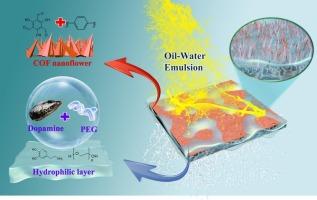Super-hydrophilic membranes fabricated by synergistic integration of covalent organic framework nanoflowers and hydrophilic layers for efficient oil-water separation
Abstract
Despite numerous advancements, the development of super-hydrophilic membranes for efficient oil-water separation remains a significant challenge due to issues such as membrane fouling and the trade-off between selectivity and permeability. This study addresses these issues by innovatively integrating covalent organic framework nanoflowers with hydrophilic layers of polydopamine and polyethylene glycol. The research introduces a novel membrane, DP/COF3/PVDF, fabricated through a layer-by-layer self-assembly process and subsequent co-deposition of dopamine and PEG, which combines the nanostructured COF with a hydrophilic coating. Experimental results reveal that the optimized membrane exhibits remarkable hydrophilicity, with a water contact angle of 17.0° and an underwater oil contact angle of 176.9°. Notably, the membrane achieves an impressive pure water flux of 3919.9 L m−2 h−1 bar−1 and a rejection rate exceeding 98.0 % across various oil-water emulsions, significantly outperforming traditional membranes. The membrane exhibits superior antifouling capabilities and stability over ten cycles of use, with negligible flux decline and consistent rejection rates, showcasing robust durability and reusability. This study's findings highlight the potential for developing next-generation super-hydrophilic membranes with improved oil-water separation efficiency and durability.


 求助内容:
求助内容: 应助结果提醒方式:
应助结果提醒方式:


